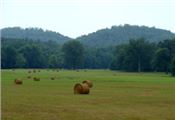Planting Depth Crucial For Forage Establishment

Many Arkansas hay producers are finding they have less to cut
since drought began to settle again in the state.
FAYETTEVILLE, ARK.
Just below the surface there is a fierce competition waging between plants for survival. Soil variability and the diversity of desired and undesired plants create a pasture environment were plants fight to survive.
There are few things that can be controlled to ensure the plants you want to survive will. One of them – and one of the most important – is planting depth. Often, seeds are planted to deep or the ground can’t be worked over and forages are planted in existing stands of perennial grasses, but each forage has its own ideal planting depth to ensure seed emergence and stand persistence.
“In general, larger seeds need to be planted deeper and smaller seeds need to be planted at a shallower depth,” said Dirk Philipp, associate professor of forages with the University of Arkansas-Division of Agriculture.
Most forages like grasses and legumes have very small seeds so planting depth is shallow, usually between one-fourth and one-half of an inch maximum.
However, pasture unevenness is more than one-fourth of an inch even across relatively small areas, making an exact and consistent planting depth difficult.
Here are Philipp’s tips and tricks to consistently planting at a shallow seeding depth:
Be meticulous with drilling machine set up. Make sure the coulters and planting wheels operate correctly. “Check coulter bearings regularly as loose planting wheels will result in uneven planting depths,” Philipp said. Planting wheels can be adjusted to a certain depth, so make sure they all have the same setting and spacing. Check to see if the seed tubes are stopped up from old seeds or spider webs, then calibrate your drill for the correct seeding rate.
Do a test run. Run the drill a few yards to check planting depth. Try to find the seeds in the row. Most of the time the seeds are hard to find. At shallow depths, some of the seeds end up on top of the planted row and are pressed into the soil by the packing wheels. That is perfectly fine.
Pick an even spot for adjusting seeding depth. This will ensure that the seeding depth will be the set depth on average across the field.
Make adjustments as you go. “Some fields are much wetter or dryer in certain spots, this will change planting depth,” Philipp said. Adjust the seeding depth in those cases. ∆